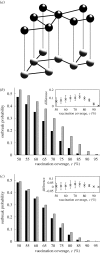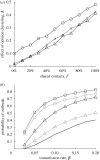Networks of influence and infection: parental choices and childhood disease - PubMed (original) (raw)
Networks of influence and infection: parental choices and childhood disease
Ken T D Eames. J R Soc Interface. 2009.
Abstract
Clusters of unvaccinated individuals are at risk of outbreaks of infection. When an individual's decision to choose vaccination is influenced by the choices of his social group, such clusters can readily arise. However, when the interactions that influence decision-making and those that permit the transmission of infection are different--for instance, when parents make vaccination decisions on behalf of their children--it is unclear how large the impact of this social influence will be. Here we use a modelling approach to represent social influence within a network of parents and the transmission of infection through a network of children. We show that the effect of social influence depends on the amount of overlap between the two different networks; large overlap means that clusters of parents who choose not to vaccinate are likely to have interacting children, generating clusters of unvaccinated children. Spatially local connections can further increase the impact of social influence. Outbreaks are most likely when parents who do not vaccinate have children who interact.
Figures
Figure 1.
(a) The model population consists of a network of parents (black, above) and a network of children (grey, below); in both networks, links (black lines) are formed locally. Each parent has exactly one child, who shares his spatial location (illustrated by grey vertical lines). Not all links between parents correspond to links between their offspring. (b) Outbreak probability with (Ω = 1, grey) and without (Ω = 0, black) opinion formation for varying vaccination coverage. The parent and offspring networks share all connections (i.e. F = 1); T = 0.2. The inset box shows how the difference in outbreak probability for Ω = 1 and Ω = 0 varies across the different stochastically generated networks (bars from 5th to 95th percentiles, with the mean shown as a cross). (c) As given in (b), but F = 0.2.
Figure 2.
(a) Impact of shared contacts, F, on the effect of opinion clustering, Δ. Results are shown for different local thresholds: T = 0.1 (circles), T = 0.2 (crosses), T = unlimited (triangles). (b) Impact of amount of agreement between parents; c = 80 per cent and β is varied. Shown is the probability of an outbreak for F = 0.2 (grey) and F = 1 (black) and for agreement between parents of 0.68 (i.e. random vaccination, solid line), 0.75 (triangles) and 0.85 (circles); T = 0.2.
Similar articles
- Preferential differences in vaccination decision-making for oneself or one's child in The Netherlands: a discrete choice experiment.
Hoogink J, Verelst F, Kessels R, van Hoek AJ, Timen A, Willem L, Beutels P, Wallinga J, de Wit GA. Hoogink J, et al. BMC Public Health. 2020 Jun 1;20(1):828. doi: 10.1186/s12889-020-08844-w. BMC Public Health. 2020. PMID: 32487041 Free PMC article. - Cognitive processes and the decisions of some parents to forego pertussis vaccination for their children.
Meszaros JR, Asch DA, Baron J, Hershey JC, Kunreuther H, Schwartz-Buzaglo J. Meszaros JR, et al. J Clin Epidemiol. 1996 Jun;49(6):697-703. doi: 10.1016/0895-4356(96)00007-8. J Clin Epidemiol. 1996. PMID: 8656233 - Measuring vaccine acceptance among Canadian parents: A survey of the Canadian Immunization Research Network.
Dubé E, Gagnon D, Ouakki M, Bettinger JA, Witteman HO, MacDonald S, Fisher W, Saini V, Greyson D; Canadian Immunization Research Network. Dubé E, et al. Vaccine. 2018 Jan 25;36(4):545-552. doi: 10.1016/j.vaccine.2017.12.005. Epub 2017 Dec 9. Vaccine. 2018. PMID: 29233605 - Parents' and informal caregivers' views and experiences of communication about routine childhood vaccination: a synthesis of qualitative evidence.
Ames HM, Glenton C, Lewin S. Ames HM, et al. Cochrane Database Syst Rev. 2017 Feb 7;2(2):CD011787. doi: 10.1002/14651858.CD011787.pub2. Cochrane Database Syst Rev. 2017. PMID: 28169420 Free PMC article. Review. - Vaccination and herd immunity to infectious diseases.
Anderson RM, May RM. Anderson RM, et al. Nature. 1985 Nov 28-Dec 4;318(6044):323-9. doi: 10.1038/318323a0. Nature. 1985. PMID: 3906406 Review.
Cited by
- Imitation dynamics of vaccination behaviour on social networks.
Fu F, Rosenbloom DI, Wang L, Nowak MA. Fu F, et al. Proc Biol Sci. 2011 Jan 7;278(1702):42-9. doi: 10.1098/rspb.2010.1107. Epub 2010 Jul 28. Proc Biol Sci. 2011. PMID: 20667876 Free PMC article. - Interdisciplinary approaches to zoonotic disease.
Goodwin R, Schley D, Lai KM, Ceddia GM, Barnett J, Cook N. Goodwin R, et al. Infect Dis Rep. 2012 Dec 4;4(2):e37. doi: 10.4081/idr.2012.e37. eCollection 2012 Apr 27. Infect Dis Rep. 2012. PMID: 24470951 Free PMC article. Review. - Echo chambers and opinion dynamics explain the occurrence of vaccination hesitancy.
Müller J, Tellier A, Kurschilgen M. Müller J, et al. R Soc Open Sci. 2022 Oct 12;9(10):220367. doi: 10.1098/rsos.220367. eCollection 2022 Oct. R Soc Open Sci. 2022. PMID: 36312563 Free PMC article. - Epidemic spreading with awareness and different timescales in multiplex networks.
da Silva PCV, Velásquez-Rojas F, Connaughton C, Vazquez F, Moreno Y, Rodrigues FA. da Silva PCV, et al. Phys Rev E. 2019 Sep;100(3-1):032313. doi: 10.1103/PhysRevE.100.032313. Phys Rev E. 2019. PMID: 31640001 Free PMC article. - Maximizing multiple influences and fair seed allocation on multilayer social networks.
Chen Y, Wang W, Feng J, Lu Y, Gong X. Chen Y, et al. PLoS One. 2020 Mar 12;15(3):e0229201. doi: 10.1371/journal.pone.0229201. eCollection 2020. PLoS One. 2020. PMID: 32163423 Free PMC article.
References
- Anderson R. M., May R. M. 1991. Infectious diseases of humans. Oxford, UK: Oxford University Press.
- Heathcock R., Watts C. 2008. Measles outbreaks in London, United Kingdom—a preliminary report. Euro Surveill. 13. - PubMed
MeSH terms
LinkOut - more resources
Full Text Sources
Medical

